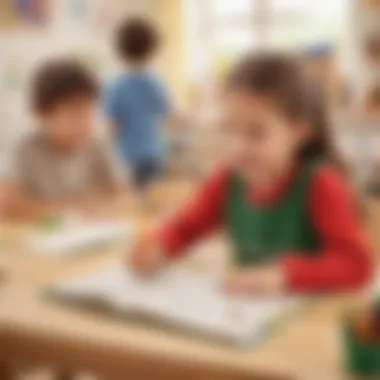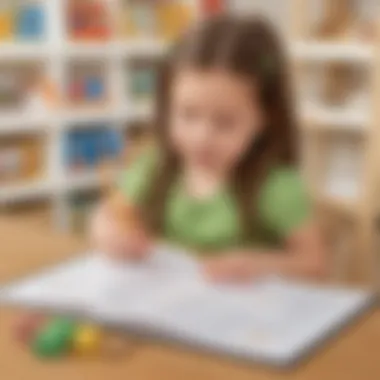Engaging Spelling Exercises for Kindergarten Learners


Intro
Teaching spelling to kindergarten children requires a thoughtful approach. In this formative stage, it is crucial to introduce spelling exercises that align with their developmental needs. Young learners benefit from activities that appeal to their imaginative nature while helping them grasp essential phonetic concepts. Engaging exercises lay the groundwork for strong language skills and foster a positive attitude toward learning.
Creative Activities
Craft Ideas
Creative activities provide children a hands-on way to connect letters and words with physical objects. For example, creating letter collages can be an exciting exercise. Children can use colored paper, glue, and magazines to cut out letters or images that start with a specific sound. This method enhances visual recognition of letters as they engage with the material.
Step-by-Step Guides
- Letter Collage: Gather materials like magazines, scissors, and glue.
- Choosing a Letter: Select a letter of the week.
- Finding Images: Help children find pictures in magazines that start with that letter.
- Assembling: Allow them to cut and glue the pictures next to the corresponding letter on a poster.
This activity not only promotes letter recognition but also enhances their fine motor skills.
Educational Value
Craft-based spelling exercises can significantly enhance learning. They encourage children to think critically about letters and sounds while promoting creativity. When children link letters with meaningful visuals, they develop better retention of spelling concepts. Moreover, these activities can strengthen the parent-child bond, as they often involve cooperative efforts.
Fun Quizzes
Quiz Topics
Quizzes present an interactive method to reinforce literacy concepts. Topics may include:
- Phonetic sounds
- Common sight words
- Vocabulary related to seasons or holidays
Question Types
Effective quizzes should incorporate a variety of question types to maintain engagement. These can involve:
- Multiple choice questions that ask children to identify correct spellings.
- Fill-in-the-blank formats with context clues.
- Matching activities where children pair words with pictures.
Knowledge Reinforcement
Engaging quizzes help children reinforce their learning in a playful manner. When quizzes focus on enjoyable themes, they often spark enthusiasm and motivation in young learners. This method can transform spelling practice into an exciting game, ensuring children remain focused and interested.
Fact-Based Articles
Topics
Fact-based articles provide a knowledge-rich resource for children. Topics could range from animals to simple geography. Children can explore diverse subjects that pique their interest, all while developing reading skills.
Engaging Content
These articles should present information clearly and accessibly. Use vivid but simple explanations. For instance, if discussing a lion, a sentence could read: "A lion is a big cat that lives in Africa and is known as the king of the jungle." Such sentences help crystallize concepts for young minds.
Foreword to Spelling in Kindergarten
Spelling holds a significant place in the early education curriculum, especially for kindergarten students. During these formative years, young learners begin to establish a foundation that will support their future language and literacy skills. This section will detail the critical role spelling plays in a child’s cognitive and academic development. It brings into focus how effective spelling exercises can promote not just literacy, but also broader skills such as communication and comprehension.
One key aspect to consider is that spelling is more than just putting letters together. It is about recognizing patterns in language. Children learn to associate sounds with letters, thereby enhancing their reading abilities. This skill is essential as it directly affects how they interact with texts. Additionally, mastering spelling fosters confidence. Children who feel confident in their spelling prowess are more likely to participate in discussions and express their thoughts in writing.
Spelling also strengthens memory and attention to detail. As children practice, they engage their brains in recognizing letters and sounds. This kind of practice helps build neural connections that are fundamental for literacy.
"Effective spelling practices in early education lay a strong foundation for lifelong language skills."
In summary, introducing spelling early in kindergarten can be a springboard to academic success and personal growth. The following sections will delve deeper into understanding the importance of spelling in young learners, along with cognitive development aspects that intertwine with spelling proficiency.


Foundational Skills for Spelling
Foundational skills play a crucial role in developing spelling abilities in young learners. These skills establish a base for children to engage with language effectively. They not only enhance spelling proficiency but also facilitate broader communication skills. Understanding these foundational aspects is key to fostering a supportive learning environment for kindergarten students.
Phonemic Awareness
Phonemic awareness is the ability to hear, identify, and manipulate individual sounds in spoken words. This skill is essential for learning how letters correlate with sounds, a concept known as phonics. When children are aware of phonemes, they can decode words more efficiently. This understanding allows them to spell words by breaking them down into their sound components.
Activities that promote phonemic awareness include:
- Rhyming games: Encourage children to find and make rhymes. This helps them hear similar sounds.
- Sound isolation: Have children identify the first, middle, and last sounds of words. This strengthens sound recognition.
- Blending sounds: Present sounds individually and ask children to blend them into a complete word.
These exercises enhance children's ability to segment and blend sounds. As a result, they develop a stronger grasp of spelling rules and patterns.
Visual Word Recognition
Visual word recognition connects the visual representation of words with their corresponding sounds and meanings. It helps children recognize words by sight, reducing the need for phonetic analysis each time they encounter a word. This skill is crucial in enabling fluid reading and effective writing.
Strategies to enhance visual word recognition include:
- Repetitive reading: Reading the same books frequently helps cement word recognition.
- Using flashcards: Create flashcards with common sight words to promote recognition and memory.
- Word walls: Display frequently used words visually in the classroom, allowing children to reference them easily.
By solidifying these connections between visual and auditory elements, children can decode more complex texts as they progress.
Contextual Understanding of Language
Contextual understanding refers to the ability to use context clues in understanding and spelling words. Young learners benefit from seeing words in meaningful sentences or stories. This approach helps them grasp the proper usage and meaning, which supports spelling.
Methods to develop contextual understanding include:
- Storytelling: Engage children in storytelling, encouraging them to use new words in context.
- Sentence building: Provide sentences with missing words and ask children to fill in the blanks, fostering understanding of usage.
- Real-life applications: Encourage children to write simple sentences about their daily experiences, reinforcing the relevance of words.
Types of Spelling Exercises
In early education, particularly in kindergarten, spelling exercises play a crucial role in language development. They serve not just to introduce children to the mechanics of spelling, but also to enhance their cognitive skills. Effective exercises can engage young learners, make learning enjoyable, and foster a strong foundation in language. Various types of spelling exercises cater to different learning preferences, which is essential as kindergarten students often demonstrate a range of abilities and interests.
The focus should be on three core exercise types: Repetition and Writing Drills, Visual Aids and Flashcards, and Interactive Games and Activities. By applying these varied methods, educators can keep students motivated and attentive, adapting the practices to meet the needs of each child.
Repetition and Writing Drills
Repetition remains a fundamental principle in learning. Through consistent writing drills, children can internalize spelling patterns and improve their muscle memory when it comes to writing letters. Simple exercises like writing words multiple times or filling in blanks can be effective. These activities can also help solidify phonemic awareness, as children hear and articulate each sound as they write.
Moreover, these drills can work well whether done individually or in a group setting. A group can create a sense of community, while individual practices cater to those who may need more focused attention. Regular repetition leads to increased confidence when moving on to more complex spelling tasks.
Visual Aids and Flashcards
Visual aids, especially flashcards, provide a rich resource in younger education settings. Flashcards can create a fun and interactive way for children to learn new words. They often incorporate colorful images associated with the words, making connections in the child’s mind. This approach is particularly useful as it leverages visual learning, aiding retention and recall.
Teachers can flip the flashcards and ask students to spell the word aloud. This method can help build not only spelling skills but also verbal skills. Regular exposure through flashcards can cultivate a deeper familiarity with words and their spellings, making it easier for children to recognize and write them in the future.
Interactive Games and Activities
Incorporating games into spelling exercises can significantly enhance engagement among kindergarten students. Games provide a playful context for learning. Board games or digital apps that focus on spelling can stimulate interest and competition while reinforcing learned skills.
For example, spelling bees, scavenger hunts, or memory matching games can motivate children to participate actively. These activities offer immediate feedback, helping students recognize their strengths and areas for improvement. Additionally, they encourage collaboration among peers, fostering both social and emotional skills alongside academic ones.
"Games and activities transform learning into an experience rather than a task, making young learners excited about spelling."
Ultimately, by utilizing a combination of different types of exercises, educators and parents can create a comprehensive spelling program that not only develops proficiency but also fosters a lifelong love for language.
Implementing Spelling Exercises


Implementing effective spelling exercises is essential for young learners. Doing so allows educators to leverage specific strategies that encourage mastery of spelling skills. The focus should always be on exercises that not only teach but also engage children. A systematic approach makes it easier for children to grasp the concepts, build confidence, and enjoy the learning process.
Moreover, taking the time to implement well-structured spelling activities ensures that students develop a strong foundation. This foundation is critical as they progress in their literacy journey. Each exercise should be designed with developmental appropriateness in mind, catering to the unique needs of each child.
Creating a Routine for Practice
Establishing a consistent routine for spelling practice is vital. Children thrive on repetition and structure, making routines a key element in their learning. Creating a specific time for spelling each day helps children recognize its importance. This daily commitment can enhance their retention and understanding of words.
Educators should consider a variety of activities during these practice sessions. Mixing traditional writing drills with more interactive methods can maintain children's engagement. For instance, alternate between writing words on a board and using flashcards for a more dynamic experience.
A useful method is to integrate spelling practice into everyday activities. Naming objects around the classroom or home can subtly reinforce their learning. Additionally, parents can take an active role by encouraging spelling games during family time. This not only reinforces what they learn at school but also fosters a supportive home environment.
Setting Achievable Goals
Setting realistic goals is another critical step in implementing spelling exercises. Young learners can feel overwhelmed by overly ambitious expectations. This can lead to frustration and disengagement. Instead, it is essential to set targets that are challenging yet attainable.
Starting with a small number of words each week can provide clear successes that motivate children. As their skills improve, gradually increase the complexity of the words or the number of words each week. Encouraging children to reflect on their progress is also beneficial. This reflection can happen through simple checklists or discussions about their learning experiences.
Setting achievable goals not only enhances spelling skills but also builds confidence, creating a positive loop of learning.
Overall, focusing on creating a routine and setting achievable goals throughout the implementation of spelling exercises ensures a structured approach. These strategies enhance children's learning experiences and allow them to thrive in their spelling abilities.
Differentiating Instruction
Differentiating instruction is a crucial component in teaching spelling to kindergarten students. Each child has unique needs, capabilities, and learning styles. Therefore, it is essential to recognize that a one-size-fits-all approach may not be effective. Tailoring exercises helps to ensure that all children can engage with spelling activities meaningfully. By accommodating various skills and preferences, educators can nurture a more supportive and effective learning environment.
Tailoring Exercises to Student Needs
When designing spelling exercises, it is important to assess individual student needs. Some children may grasp phonetic concepts quickly, while others may require more repetition and practice. Tailoring exercises involves creating modifications that cater to these differences.
- Use assessment tools to identify where each child stands in their spelling journey. This can be informal, like observing students during activities, or formal, like spelling tests.
- Group students with similar needs together. This encourages peer learning and allows for targeted instruction that addresses what they specifically struggle with.
- Provide options for activities. For instance, some students may benefit from writing words out multiple times, while others might prefer using digital tools or interactive games.
This tailored approach not only helps to build confidence but also fosters a sense of ownership over their learning process.
Incorporating Diverse Learning Styles
Every child learns differently, and recognizing this allows educators to employ various teaching strategies that align with these learning styles. By incorporating different modalities into spelling instruction, educators can enhance student engagement and learning outcomes.
- Visual learners might benefit from colorful flashcards or pictures that represent words. These can be great for associating sounds with letters.
- Auditory learners can gain from spelling out words verbally, listening to spelling songs, or engaging in rhymes that reinforce sounds within words.
- Kinesthetic learners need to be active in their learning, so utilizing hands-on activities like letter building with clay can be vital for their understanding.
By embracing these diverse learning styles, teachers can create a rich learning environment. Understanding how each student learns contributes to a supportive atmosphere where all children can flourish. Integrating these strategies into daily learning will not only aid in spelling proficiency, but also foster a love for language and education.
"Every child can learn. Just not on the same day, or in the same way."
– George Evans
Assessment of Spelling Proficiency
Assessment of spelling proficiency is vital in understanding students' progress and identifying areas for improvement. This process not only measures the effectiveness of the teaching methods used but also offers insights into each child’s unique learning journey. By assessing spelling skills, educators can tailor their approaches, ensuring that students receive the support they need.
Effective assessment should encompass various dimensions. Teachers can use multiple methods including informal observations, structured tests, and interactive spelling games to gather data on students’ abilities. Monitoring these skills helps in planning further learning activities and provides a foundation for future literacy achievements.
Identifying Progress and Challenges
Identifying progress and challenges in spelling proficiency is central for guiding instruction in kindergarten classrooms. Regular assessments allow teachers to observe which words students spell accurately and where they struggle. For instance, a student may excel at spelling simple sight words but face difficulty with phonetic words. Knowing this information helps teachers adapt their lessons by either reinforcing basic skills or introducing new challenges.
Additionally, documenting progress can build a sense of accomplishment in young learners. Teachers can maintain individualized records which reflect each student’s spelling development over time. This could be done through simple checklists, trackers, or portfolios that display student work and milestones achieved.
Utilizing Digital Tools for Assessment
In the digital age, utilizing technology for assessment can enhance the process significantly. There are numerous digital tools available that provide teachers with efficient ways to evaluate spelling skills. For instance, applications like Quizlet and SpellingCity allow educators to create customized spelling tests that can adapt according to the student's level.
These platforms offer immediate feedback, which is an essential aspect of learning. Instant results help students understand their mistakes and encourage self-correction. Moreover, many programs track progress over time, showcasing improvements or identifying persistent challenges, thus streamlining the assessment process.


Technology can transform traditional assessment techniques, making them more engaging for young learners.
Engaging Parents in Spelling Activities
Engaging parents in spelling activities is vital for reinforcing the learning that occurs in the classroom. When parents actively participate, they create an environment that fosters language development and encourages a lifelong love of learning. The involvement of parents also bridges the gap between school and home, making it easier for children to practice their spelling skills in a supportive setting.
Diverse strategies can be utilized to involve parents. First, they can be provided with resources that guide home practice. This makes it easier for them to assist their children without having to navigate the complexities of spelling education alone. Key aspects include organizing spelling lists, suggesting activities, and sharing best practices that align with what is taught in school.
Another significant benefit is that engaged parents can observe firsthand their child's progress. They can identify strengths and weaknesses, offering tailored support. When children see their parents taking an interest, it also boosts their motivation and confidence.
Providing Resources for Home Practice
To effectively engage parents, it is essential to provide clear and accessible resources for home practice. Tools such as worksheets, word games, and online resources can make learning enjoyable and productive. Here are some suggestions to consider:
- Worksheets: Offer a variety of spelling worksheets that focus on different words and themes. Create ones that have engaging layouts and clear instructions.
- Word Games: Introduce games like word searches, crossword puzzles, or bingo that make practicing spelling fun.
- Online Resources: Share platforms that offer interactive exercises such as Starfall or ABCmouse, which also provide parents with progress tracking options.
These resources not only serve as a guide for parents but also provide children with a variety of activities to keep their interest alive. Parents should be encouraged to promote consistent practice while making it engaging and enjoyable.
Encouraging a Collaborative Learning Environment
Creating a collaborative learning environment helps solidify spelling skills and enhances communication between child and parent. One effective way to foster this environment is through regular discussions about progress and challenges. When parents talk to their children about what they are learning, it reinforces the content and encourages them to voice any difficulties they may have.
Additionally, consider setting up spelling practice sessions at home where the parent and child can work together. This could involve simple activities:
- Spelling Bees: Parents and children can take turns quizzing each other on spelling words, making it interactive and competitive in a friendly manner.
- Story Creation: Encourage the child to create short stories using new spelling words. Discussing these stories afterwards helps deepen comprehension and retention.
Moreover, it is crucial to maintain open lines of communication with parents. Inform them about classroom strategies so they can mirror these at home. This way, parents and teachers can work hand in hand, leading to a more cohesive learning experience.
Engaging parents is not just beneficial for children’s spelling skills; it creates a supportive community that values education and personal growth.
Challenges in Teaching Spelling
Teaching spelling in kindergarten presents unique challenges that educators and parents must navigate. Understanding these challenges is crucial for effective instruction and fostering a positive learning environment. Children in this age group are rapidly developing their language skills, so they may encounter confusion around spelling rules and letter-sound relationships. By addressing these issues head-on, we can create a more supportive framework for learning spelling effectively.
One specific element to consider is phonetic discrepancies. Many children might assume that words are spelled as they sound. For example, they may struggle with words that include silent letters, such as "knee" or "island." This can lead to frustration and missteps in their spelling journey.
Another consideration is the difference in learning styles among kindergarteners. Some students may respond better to visual aids, while others might grasp concepts more effectively through hands-on activities. As a result, educators should be prepared to adapt their teaching strategies to accommodate these diverse needs.
Ultimately, recognizing the challenges in teaching spelling enables educators and parents to adopt tailored approaches for each child. Such adaptations nurture their confidence and engagement in the learning process.
Addressing Common Misconceptions
Common misconceptions about spelling can hinder a child’s progress. For many kindergarteners, the notion that letters correspond strictly to sounds leads to confusion. Educators should clarify that, despite common sounds, many rules in the English language do not apply universally. For instance, how the letter "c" might sound like an "s" in "city" but like a hard "k" in "cat."
To counter these misconceptions, it helps to provide examples and explain the nuances behind different spelling patterns. Additional methods include:
- Utilizing word families to demonstrate similar spelling and pronunciation
- Teaching sight words, as these often deviate from standard spelling rules
- Encouraging students to discover and use puzzles or games that highlight these irregularities.
Regular, open discussions about their misconceptions helps children feel valued and encourages growth.
Overcoming Hesitation and Fear of Failure
Hesitation and fear of failure can severely affect a child's willingness to engage in spelling exercises. Children may worry about making mistakes, leading to reluctance to participate in spelling activities. Educators and parents must actively work to cultivate a safe and encouraging learning environment.
Creating opportunities for success, even in small steps, is key. For example, celebrating progress—no matter how minor—helps children feel accomplished and valued. Additionally, implementation of cooperative learning activities can reduce the pressure to perform individually. Such activities promote Teamwork and peer support, making spelling more enjoyable.
It is also vital to encourage a growth mindset. Explain to students that mistakes are part of learning. Framing challenges as opportunities for improvement fosters resilience. Engaging with stories that showcase characters overcoming difficulties can illustrate this point effectively.
"Mistakes are proof that you are trying."
The End and Future Directions
The journey of teaching spelling to kindergarten students does not end with just mastering a set of words or exercises. As highlighted throughout this article, effective spelling exercises lay a strong foundation for a child’s literacy skills. Early spelling proficiency not only benefits reading abilities but also boosts confidence in communication. Understanding the importance of continued support in spelling skills is essential.
In considering the lasting impact of early spelling skills, we recognize these formative years significantly shape a child’s approach to language. Children who develop good spelling habits tend to excel in both reading and writing. Good spelling also enhances their ability to express thoughts clearly. This clarity is crucial as they progress through their educational journey. Hence, fostering these skills through purposeful exercises should be a priority for educators and parents alike.
Furthermore, emerging trends in spelling instruction offer innovative ways to engage learners. With technology becoming a pivotal part of education, digital tools and apps are changing how spelling is taught. Games, interactive quizzes, and audiovisual aids create a dynamic learning environment. This shift not only helps appeal to varied learning styles but also keeps students engaged. Educators should stay informed about these trends and consider ways to incorporate such methods into their teaching strategies.







